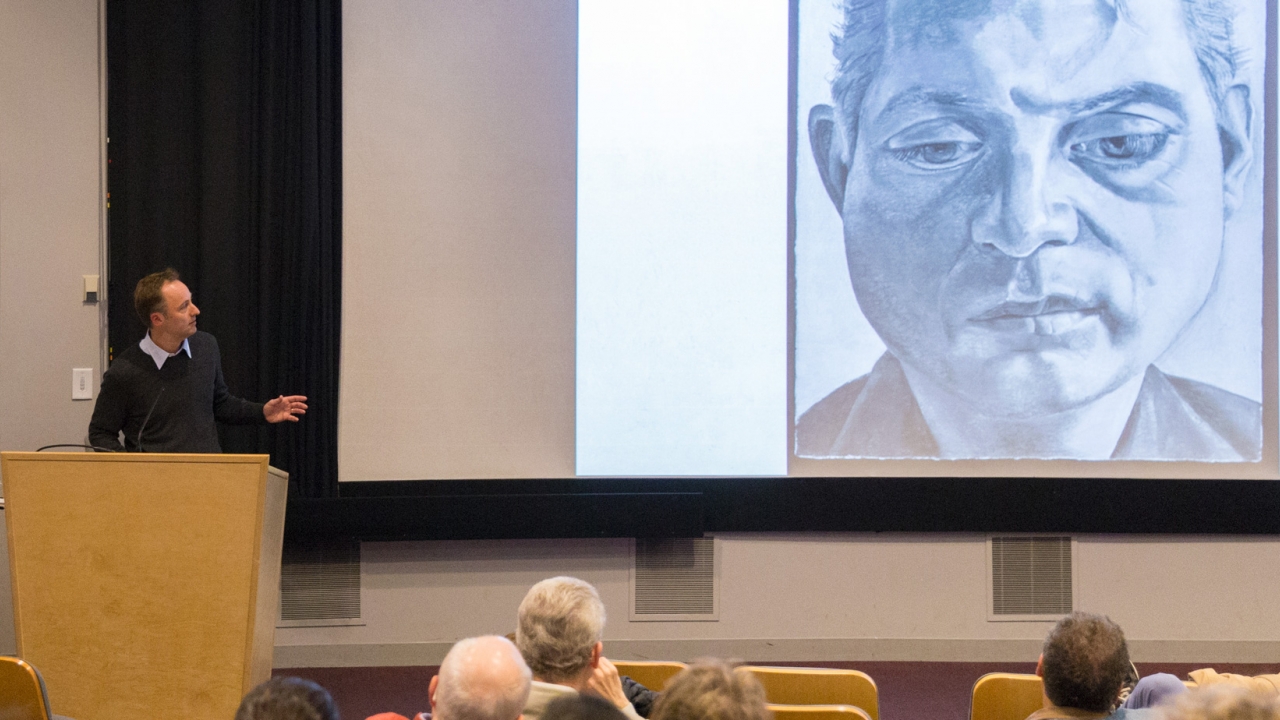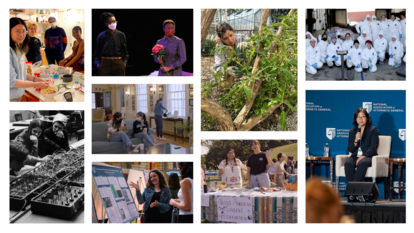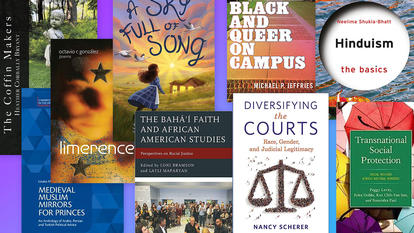Pulitzer Prize-Winning Art Critic Shares Insights About Writing

What does good writing entail? That’s a question Pulitzer Prize-winning art critic Sebastian Smee explored during this semester as he taught nonfiction prose to students in ENGL 315: The Robert Garis Seminar, named after the late critic and longtime chair of Wellesley’s English department.
Members of the Wellesley community had a chance to consider the question as well when Smee gave a lecture based on his new book, The Art of Rivalry: Four Friendships, Betrayals, and Breakthroughs in Modern Art, in Collins Cinema on November 29.
When introducing Smee, William Cain, Mary Jewett Gaiser Professor of English, praised his insight into how admiration and envy spurred Édouard Manet and Edgar Degas, Pablo Picasso and Henri Matisse, Jackson Pollock and Willem de Kooning, and Lucian Freud and Francis Bacon to reach new artistic heights. Cain also said Smee’s writing has an engaging voice that makes the reader “feel joy and energy in response to works of art.”
In his opening remarks, Smee explained that the book was inspired in part by his feeling “that there was an intimacy—at times an almost tragic intimacy—in certain key relationships that was moving in human terms, but also ended up being hugely consequential artistically.” Smee said, “I wanted to know more.”
The more Smee researched, the more he realized that the artists both benefitted and suffered from the intimacy and openness they shared. “These relationships are inherently volatile,” he said. “They are fraught with slippery psychodynamics…Nor do they end well.”
In the case of Freud and Bacon, the focus of Smee’s lecture, the volatility lasted for decades. “Bacon’s influence touched everything,” Smee said. “If his company triggered many changes in Freud’s life, it also triggered a veritable, if slow-burning, crisis in his art. It affected not just Freud’s method but also his feeling about subject matter and his fundamental sense of what, for him, was possible.”
After the event, Smee described his philosophy as a critic. “I try to approach every art show and every art work with not just an open mind, but an impulse to admire what I see. It’s possible for that impulse to be disappointed, of course, and it is my responsibility to be honest about that,” he said. “But I think you have to bring a measure of sympathetic enthusiasm to every encounter.”
He continued: “I write with a general reader in mind, and in a tone that I hope is unpretentious, personal, informative, and lively.”
Smee encouraged students in the Garis Seminar to do the same. The course focused on “literary journalism,” a form of nonfiction prose that combines factual reporting with the narrative elements and psychological insight expected in fiction. The class analyzed and emulated the work of writers such as Janet Malcolm, Helen Garner, Peter Schjeldahl, and Josephine Herbst. Over the course of the semester, each student wrote and revised a roughly 5,000-word piece on the topic of her choice. The subjects they covered included religious rituals in India, luxury hotels in Beijing, and urban farming in Roxbury, Mass.
Despite the research and technical precision necessary, “I didn’t want students to conceal what they don’t know in jargon and credential-building, but rather to write from the heart about what they do know and what they care about or have just found out about,” said Smee, who has taught the seminar three times since 2012 and will begin a year-long sabbatical in his native Australia next month. “I hoped to encourage them to write in mature, sophisticated ways about things that feel urgent to them.”
When asked if his own subject matter—rivalry and creative breakthroughs—applies to writers as well, Smee says the dynamic is visible everywhere, including in literature. “One thinks of the complex relationships between Wordsworth, Coleridge, and Keats, or John Updike and Philip Roth, who were mutually admiring and famously competitive. Rivalry is also the explicit subject of some great literature, including Elena Ferrante’s wonderful series of novels.”
One a more basic level, he said, rivalry contributes to finding one’s voice, which is necessary for every student, and every critic. “Somehow, there seems to be a need, after falling under another’s spell, to kick away from that, in order to force the issue of your own identity—defining who you are and what you can do, as opposed to what the other is and what she or he expects of you,” he said.



